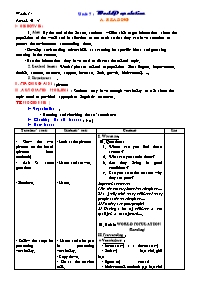Bài soạn môn học Tiếng Anh 11 - Period 40, 41 - Unit 7: World population a - Reading

I- OBJECTIVES:
1. Aim: By the end of the lesson, students will be able to get information about the population of the world and its affection to our earth so that they can have attention to protect the environment surrounding them.
- Develop such reading micro-skills as scanning for specific ideas and guessing meaning in the context.
- Use the information they have read to discuss the related topic.
2. Lexical items: Words/ phrases related to population like : fingure, improvement, double, amount, resource, support, increase, limit, growth, birth-control, .
3. Structures: .
II. TEACHING AIDS: pictures
III. ANTICIPATED PROBLEMS: Students may have enough vocabulary to talk about the topic need to provided appropriate linguistic resources.
VI- PROCEDURES:
1- Organization:
- Greeting and checking the sts attendance
2- Checking the old lesson:( No )
Week: 14 Unit 7 : World Population Period: 40 +41 A- Reading I- objectives: 1. Aim: By the end of the lesson, students will be able to get information about the population of the world and its affection to our earth so that they can have attention to protect the environment surrounding them. - Develop such reading micro-skills as scanning for specific ideas and guessing meaning in the context. - Use the information they have read to discuss the related topic. 2. Lexical items: Words/ phrases related to population like : fingure, improvement, double, amount, resource, support, increase, limit, growth, birth-control, . 3. Structures: . II. Teaching aids: pictures III. Anticipated problems: Students may have enough vocabulary to talk about the topic need to provided appropriate linguistic resources. VI- Procedures: 1- Organization: - Greeting and checking the sts’ attendance 2- Checking the old lesson:( No ) 3- New lesson Teacher’ s acts Students’ acts Content Sup - Show the two pictures on the board (pictures from textbook) - Ask Ss some questions - Introduce. - Follow the steps for presenting vocabulary. - Show the poster. - Ask Ss to do. - Ask Ss to open their books and read silently. - Get feedback & correct - Ask Ss to answer the questions. -Get feedback & correct: - Ask Ss to work in pairs - Give assignment instruct Ss to do the first 4 sentences. - correct: - Ask Ss to do the rest at home (sentences: 4,5,6,7,8 page: 82) - Look at the pictures - Listen and answer. - Listen. - Listen and take part in presenting vocabulary. - Copy down. - Do as the teacher tells. - Guess and give the answer T or F - Read the text and check the answer T/F - Work in pairs to five the answers. - Copy down. - Work in pairs and give the answer - Look at the text book and do (pair work) - Copy - Listen. I. Warm up: @. Questions: Where can you find these scenes? What can you see in them? Are they living in good conditions? Can you state the reasons why they are poor? Expected answers: 1/ In the country/ town/ market place, 2/ a family with many children/ many people at the market place, 3/ No (they are poor people) 3/ Having a lot of children -> not qualified -> out of work, . @. Unit 3: WORLD POPULATION (Reading) II. Pre-reading: + Vocabulary : - increase (v) > < decrease (v) - limit (v) haùn cheỏ, giụựi haùn - figure (n) con soỏ - birth-control method: p.p haùn cheỏ sinh ủeỷ - family planning: k.hoaùch hoựa g.ủỡnh - overpopulation (n) sửù ủoõng daõn quaự mửực - Third World (n) Theỏ giụựi thửự ba - available (adj) coự saỳn * Checking : R & R + Pre-question: True or False: The world’s p_ will no longer increase. There is enough water for all the people in the world. It is difficult for women in Third World to limit the size of their families. III. While-reading: @. Give the answer to the Pre-question 1/ F 2/ F 3/ T @. Answer the following questions Expected answers : 1. (the figures in textbook) 2. 7 billion. 3. Some scientists say it can, others say it can’t. 4. no, they don’t. 5.because they know of no safe way to have fewer children. IV. Post-reading : A. Discussion: Find out 5 world largest countries in population. Where are they? Which is the richest / poorest country? B. Fill each blank with a suitable word from the box (Task 1) limit, figures, method, although, control, increase, international, resources 1. ______ most journalists studied journalism in college, some older writers never attended a university. 2. Can you explain the _____ for changing salt water to fresh water? 3. The number of injuries from automobile accidents ______ every year. 4. Some countries are poor because they have very few ______. 1/ although 2/ method 3/ increase 4/ resources V. Homework: Do at home: Task 1 (cont.) Prepare the next part of the lesson.
Tài liệu đính kèm:
 AV11(T40 - 41).doc
AV11(T40 - 41).doc





